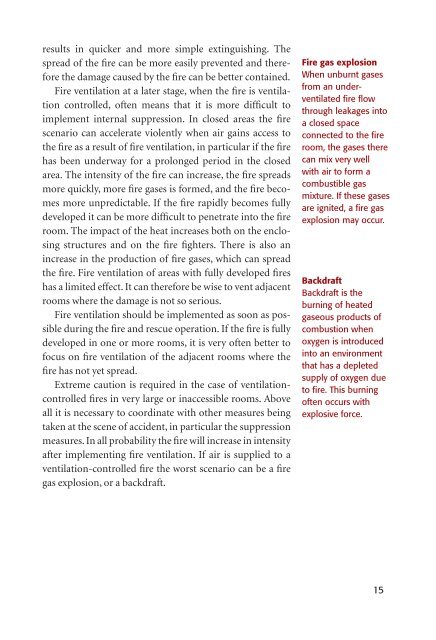Fire ventilation
Fire ventilation
Fire ventilation
You also want an ePaper? Increase the reach of your titles
YUMPU automatically turns print PDFs into web optimized ePapers that Google loves.
esults in quicker and more simple extinguishing. The<br />
spread of the fi re can be more easily prevented and therefore<br />
the damage caused by the fi re can be better contained.<br />
<strong>Fire</strong> <strong>ventilation</strong> at a later stage, when the fi re is <strong>ventilation</strong><br />
controlled, often means that it is more diffi cult to<br />
implement internal suppression. In closed areas the fi re<br />
scenario can accelerate violently when air gains access to<br />
the fi re as a result of fi re <strong>ventilation</strong>, in particular if the fi re<br />
has been underway for a prolonged period in the closed<br />
area. The intensity of the fi re can increase, the fi re spreads<br />
more quickly, more fi re gases is formed, and the fi re becomes<br />
more unpredictable. If the fi re rapidly becomes fully<br />
developed it can be more diffi cult to penetrate into the fi re<br />
room. The impact of the heat increases both on the enclosing<br />
structures and on the fi re fi ghters. There is also an<br />
increase in the production of fi re gases, which can spread<br />
the fi re. <strong>Fire</strong> <strong>ventilation</strong> of areas with fully developed fi res<br />
has a limited effect. It can therefore be wise to vent adjacent<br />
rooms where the damage is not so serious.<br />
<strong>Fire</strong> <strong>ventilation</strong> should be implemented as soon as possible<br />
during the fi re and rescue operation. If the fi re is fully<br />
developed in one or more rooms, it is very often better to<br />
focus on fi re <strong>ventilation</strong> of the adjacent rooms where the<br />
fi re has not yet spread.<br />
Extreme caution is required in the case of <strong>ventilation</strong>controlled<br />
fi res in very large or inaccessible rooms. Above<br />
all it is necessary to coordinate with other measures being<br />
taken at the scene of accident, in particular the suppression<br />
measures. In all probability the fi re will increase in intensity<br />
after implementing fi re <strong>ventilation</strong>. If air is supplied to a<br />
<strong>ventilation</strong>-controlled fi re the worst scenario can be a fi re<br />
gas explosion, or a backdraft.<br />
<strong>Fire</strong> gas explosion<br />
When unburnt gases<br />
from an underventilated<br />
fi re fl ow<br />
through leakages into<br />
a closed space<br />
connected to the fi re<br />
room, the gases there<br />
can mix very well<br />
with air to form a<br />
combustible gas<br />
mixture. If these gases<br />
are ignited, a fi re gas<br />
explosion may occur.<br />
Backdraft<br />
Backdraft is the<br />
burning of heated<br />
gaseous products of<br />
combustion when<br />
oxygen is introduced<br />
into an environment<br />
that has a depleted<br />
supply of oxygen due<br />
to fi re. This burning<br />
often occurs with<br />
explosive force.<br />
15

















